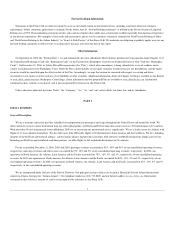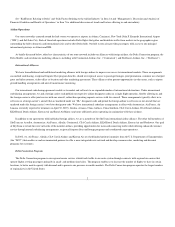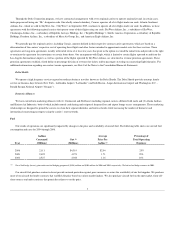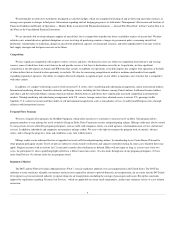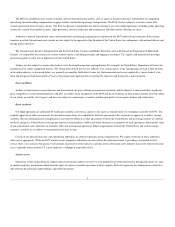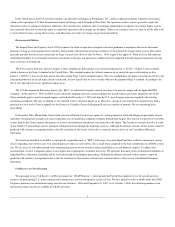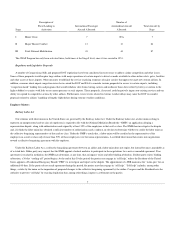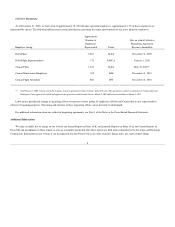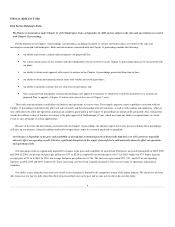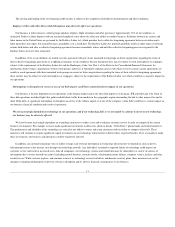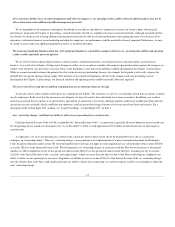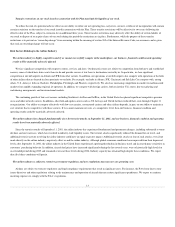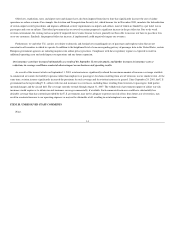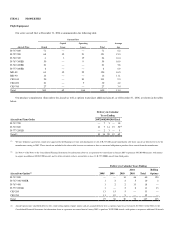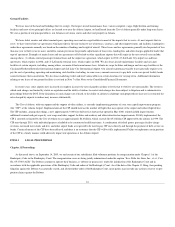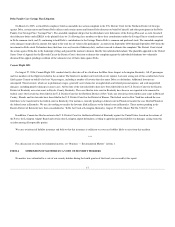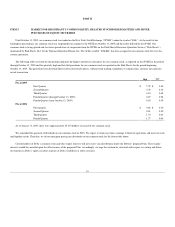Delta Airlines 2006 Annual Report Download - page 16
Download and view the complete annual report
Please find page 16 of the 2006 Delta Airlines annual report below. You can navigate through the pages in the report by either clicking on the pages listed below, or by using the keyword search tool below to find specific information within the annual report.
The closing and funding of the exit financing credit facility is subject to the completion of definitive documentation and other conditions.
Employee strikes and other labor-related disruptions may adversely affect our operations.
Our business is labor intensive, utilizing large numbers of pilots, flight attendants and other personnel. Approximately 18% of our workforce is
unionized. Strikes or labor disputes with our unionized employees may adversely affect our ability to conduct business. Relations between air carriers and
labor unions in the United States are governed by the Railway Labor Act, which provides that a collective bargaining agreement between an airline and a
labor union does not expire, but instead becomes amendable as of a stated date. The Railway Labor Act generally prohibits strikes or other types of self-help
actions both before and after a collective bargaining agreement becomes amendable, unless and until the collective bargaining processes required by the
Railway Labor Act have been exhausted.
In addition, if we or our affiliates are unable to reach agreement with any of our unionized work groups on future negotiations regarding the terms of
their collective bargaining agreements or if additional segments of our workforce become unionized, they may be subject to work interruptions or stoppages,
subject to the requirements of the Railway Labor Act and the Bankruptcy Code. See Note 1 of the Notes to the Consolidated Financial Statements for
information about Comair’s negotiations with its work groups. Likewise, if third party regional carriers with whom we have contract carrier agreements are
unable to reach agreement with their unionized work groups on current or future negotiations regarding the terms of their collective bargaining agreements,
those carriers may be subject to work interruptions or stoppages, subject to the requirements of the Railway Labor Act, which could have a negative impact on
our operations.
Interruptions or disruptions in service at one of our hub airports could have a material adverse impact on our operations.
Our business is heavily dependent on our operations at the Atlanta Airport and at our other hub airports in Cincinnati, JFK and Salt Lake City. Each of
these hub operations includes flights that gather and distribute traffic from markets in the geographic region surrounding the hub to other major cities and to
other Delta hubs. A significant interruption or disruption in service at the Atlanta airport or at one of the company’s other hubs could have a serious impact on
our business, financial condition and results of operations.
We are increasingly dependent on technology in our operations, and if our technology fails or we are unable to continue to invest in new technology,
our business may be adversely affected.
We have become increasingly dependent on technology initiatives to reduce costs and to enhance customer service in order to compete in the current
business environment. For example, we have made significant investments in delta.com, check-in kiosks, “Delta Direct” phone banks and related initiatives.
The performance and reliability of the technology are critical to our ability to attract and retain customers and our ability to compete effectively. These
initiatives will continue to require significant capital investments in our technology infrastructure to deliver these expected benefits. If we are unable to make
these investments, our business and operations could be negatively affected.
In addition, any internal technology error or failure or large scale external interruption in technology infrastructure we depend on, such as power,
telecommunications or the internet, may disrupt our technology network. Any individual, sustained or repeated failure of technology could impact our
customer service and result in increased costs. Like all companies, our technology systems and related data may be vulnerable to a variety of sources of
interruption due to events beyond our control, including natural disasters, terrorist attacks, telecommunications failures, computer viruses, hackers and other
security issues. While we have in place, and continue to invest in, technology security initiatives and disaster recovery plans, these measures may not be
adequate or implemented properly to prevent a business disruption and its adverse financial consequences to our business.
11


